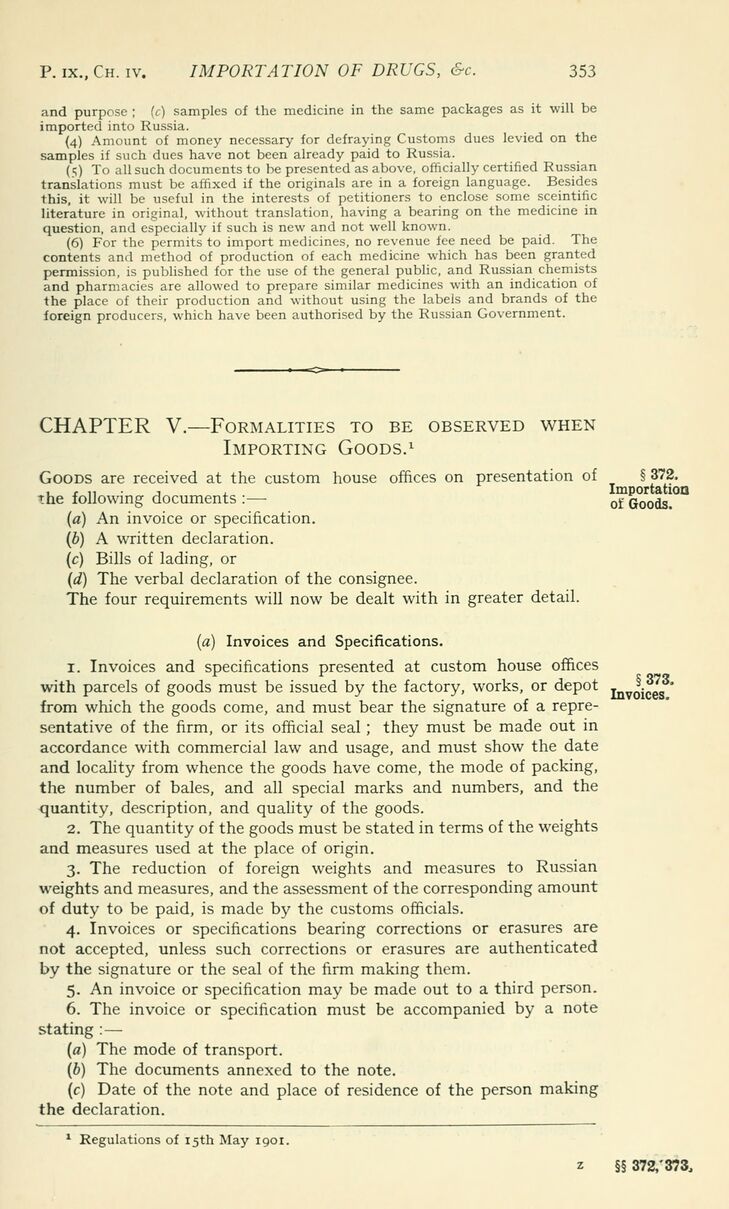
Full resolution (JPEG) - On this page / på denna sida - Pages ...

<< prev. page << föreg. sida << >> nästa sida >> next page >>
Below is the raw OCR text
from the above scanned image.
Do you see an error? Proofread the page now!
Här nedan syns maskintolkade texten från faksimilbilden ovan.
Ser du något fel? Korrekturläs sidan nu!
This page has never been proofread. / Denna sida har aldrig korrekturlästs.
P. ix., Сн. iv. IMPORTATION OF DRUGS, &c.
353
and purpose ; (c) samples of the medicine in the same packages as it will be
imported into Russia.
(4) Amount of money necessary for defraying Customs dues levied on the
samples if such dues have not been already paid to Russia.
(5) To all such documents to be presented as above, officially certified Russian
translations must be affixed if the originals are in a foreign language. Besides
this, it will be useful in the interests of petitioners to enclose some sceintific
literature in original, without translation, having a bearing on the medicine in
question, and especially if such is new and not well known.
(6) For the permits to import medicines, no revenue fee need be paid. The
contents and method of production of each medicine which has been granted
permission, is published for the use of the general public, and Russian chemists
and pharmacies are allowed to prepare similar medicines with an indication of
the place of their production and without using the labels and brands of the
foreign producers, which have been authorised by the Russian Government.
CHAPTER V.—Formalities to be observed when
Importing Goods.1
Goods are received at the custom house offices on presentation of
the following documents :—
(a) An invoice or specification.
(b) A written declaration.
(c) Bills of lading, or
(d) The verbal declaration of the consignee.
The four requirements will now be dealt with in greater detail.
(я) Invoices and Specifications.
1. Invoices and specifications presented at custom house offices
with parcels of goods must be issued by the factory, works, or depot
from which the goods come, and must bear the signature of a
representative of the firm, or its official seal; they must be made out in
accordance with commercial law and usage, and must show the date
and locality from whence the goods have come, the mode of packing,
the number of bales, and all special marks and numbers, and the
quantity, description, and quality of the goods.
2. The quantity of the goods must be stated in terms of the weights
and measures used at the place of origin.
3. The reduction of foreign weights and measures to Russian
weights and measures, and the assessment of the corresponding amount
of duty to be paid, is made by the customs officials.
4. Invoices or specifications bearing corrections or erasures are
not accepted, unless such corrections or erasures are authenticated
by the signature or the seal of the firm making them.
5. An invoice or specification may be made out to a third person.
6. The invoice or specification must be accompanied by a note
stating :—
(a) The mode of transport.
(b) The documents annexed to the note.
(c) Date of the note and place of residence of the person making
the declaration.
§ 372.
Importation
of Goods.
1 Regulations of 15th May 1901.
z §§ 372/373,
§ 373.
Invoices.
<< prev. page << föreg. sida << >> nästa sida >> next page >>